

Kennox House is situated on Kilwinning Road between Stewarton to Torranyard in North Ayrshire, Parish of Dunlop, Scotland. The house overlooks the Glazert Burn, which runs into the Annick Water at Watermeetings.


Kennox House is situated on Kilwinning Road between Stewarton to Torranyard in North Ayrshire, Parish of Dunlop, Scotland. The house overlooks the Glazert Burn, which runs into the Annick Water at Watermeetings.

Kennox house was originally called Crivoch and a house nearby still retains that name. Sir Neil Montgomery of Lainshaw married Elizabeth Cunninghame of Aiket and one of their sons, John of Cockilbie, had a son named John of Crivoch in the mid-17th century. He may have lived at Crivoch before it was purchased by the Somervilles. [1] The letters of Sir David Cunningham of Auchenharvie to his cousin the laird of Robertland preserved in the National Archives of Scotland detail his efforts to purchase some of these lands (NAS GD237/25/1-4) He sold some of them in turn to James Douglas of Chesters in 1642 (RGS, ix, (1634–1651), no.1189) In 1691 the Hearth Tax records show the Lands of Crivoch with twelve families and the largest dwelling, that of Mistress Miller, possessing four. [2]
| Etymology |
| The name 'Glazert' may come from the Celtic, glas in Gaelic meaning grey or green and dur meaning water. [3] |
In around 1700 John Somerville of the Kennox Estate in Lanarkshire purchased the Bollingshaw (now Bonshaw) Barony and built Kennox House (also Kenox in 1832 and Kennoch in 1792) on the lands of Montgomerie - Crevoch. [1] John Somerville married Janet, eldest daughter and heiress of Alexander Montgomerie of Assloss House (previously Aslois, Sloss or Asloace) near Kilmarnock. The family sold Assloss in 1725. [4]

William Somerville succeeded to the Kennox property in 1743 and married Lilias Porterfield of Hapland. A daughter, Janet, married Charles McAlester, 12th of Loup, in 1792, only son of Angus McAlester of Loup, Chief of the Clan MacAlister, who died in 1797. He assumed the name and arms of Somerville along with his own. He died in 1847 and was succeeded by his son, Charles. [5]
Patterson records that the McAlester's were Jacobites and had lost their estates and money after 1745, however this marriage restored their fortunes and, as stated, 'Somerville' has been retained in the patronym and coat of arms. Charles was succeeded by his son, Charles. Charles Somerville McAlester of Loup and Kennox died in 1903 and was succeeded by his son, Charles Godfrey Somerville McAlester of Loup and Kennox. [5]
Colonel Charles McAlester, Laird of Loup and Kennox, became Deputy Lieutenant of Ayrshire, and Commandant of the first regiment of Ayrshire Local Militia. It is recorded that when the regiment was disbanded he kept the banners, instruments and other items at Kennox, saying that "if anyone had a better claim" he would release the items to them. [6]
Captain Charles Somerville McAlester married Williamina P. Pollok - Morris of Craig House. She died aged 27 in 1872 and is buried in Saint Maurs - Glencairn church with her parents and not with her husband. This arrangement is rather unusual and may have been a family tradition judging by the other married daughters buried here with the family. Kennox is not even in the same Parish as Craig House.
Charles Somerville McAlister and Janet had four children. They bequeathed the part of the Barony of Bollingshaw named Chapelton to their younger son James, who never married and died in 1857. Charles the father died in 1847 and his eldest son, also called Charles Somerville McAlester, born in 1828 and married to Mary Brabazon, inherited the Kennox estate. It is recorded by Dobie that the older Charles was an eccentric and was one of the last of the country squires of old in his attitudes and behaviour.

The current chief of the clan is William St John Somerville McAlester of Loup and Kennox who lives in England. The current chief is a member of The Standing Council of Scottish Chiefs. Today (2010) there is a clan centre located at Glenbarr Abbey. [5]
The estate consisted of the lands of Crevoch - Lindsay, Crevoch - Montgomerie, part of the lands of Bonshaw and the lands of Fairlie - Crevoch, including the chapel lands and the glebe. These chapel lands would have been held in mortmain until after the reformation. [7] The old cottage beyond the site of the old mill was known as Crevoch and a building of that name is placed in this area in Timothy Pont's map of 1604. Fairlie - Crevoch is situated near Cunninghamhead and a Fairlie - Crevoch Mill existed on the Annick Water near Ramstane (1860 OS), however this had been known as Scroaggy or Scroaggie Mill until after the 'Kennox' Crevoch mill fell into disuse.
James Somerville obtained Chapelton, however we know from Dobie that James McAlister, nephew of the aforementioned James, was the owner in 1874. This James McAlister, the nephew of James Somerville, also never married. Chapelton had been re-acquired into the Bollingshaw Barony for him by his father, Charles McAlister. [1]


Major McAlester of Kennox, then a heritor of Dunlop church, obtained the 1792 bell and Miss McAlester and Mr.Charles G. S. McAlester returned it to the Kirk Session in 1935 to honour the centenary of the present church. [8]
Charles Somerville MacAllister was one of the stewards at the great banquet held after the Eglinton Tournament. [9]
Colonel and Mrs MacAllister attended the famous 1839 Eglinton Tournament in what is now Eglinton Country Park and were allotted a seat in the Grand Stand. [10]
The Glazert burn, previously Glazart [11] has otters and the rare freshwater mussel (source of freshwater pearls) as witnessed by broken shells found scattered on the river bank.
Over many years this society paid several visits to Kennox and on one visit in 1930 they were told by McAlister, the Laird of Loup and Kennox, that the nearby name Gallowayford is derived from the Gallows which permanently stood beside the ford on the Glazert. [6] It was also noted that an ancient Yew tree grew in the grounds which challenged the Loudoun Castle yew in size and antiquity. A very fine specimen of a Hornbeam was also noted.
Kennox possesses one of the few surviving, although long unused, Saw pits, clearly marked on the first edition of the OS map. These pits were used for cutting local timber into planks, stobs and other forms of timber for fencing, building, etc. The site is next to the Glazert Water (Glassard in 1779) [12] which runs through the estate. An early OS map shows a track running from the saw pit up across the leat and towards the entrance to Bickethall. [13]
Chapeltoun is an estate on the banks of the Annick Water in East Ayrshire, a rural area of Scotland famous for its milk and cheese production and the Ayrshire or Dunlop breed of cattle.
Lambroughton is a village in the old Barony of Kilmaurs, Scotland. This is a rural area famous for its milk and cheese production and the Ayrshire or Dunlop breed of cattle.
Cunninghamhead is a hamlet in North Ayrshire, Scotland. It was the centre of the lands of Cunninghamhead, Perceton and Annick Lodge in Cunninghame. This mainly rural area is noted for its milk and cheese production and the Ayrshire, Cunninghame or Dunlop breed of cattle.

The old Barony and castle of Corsehill lay within the feudal Baillerie of Cunninghame, near Stewarton, now East Ayrshire, Scotland.
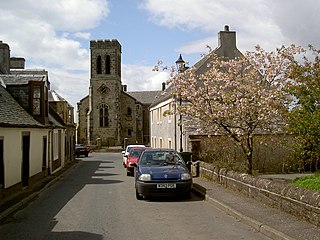
Dunlop is a village and parish in East Ayrshire, Scotland. It lies on the A735, north-east of Stewarton, seven miles from Kilmarnock. The road runs on to Lugton and the B706 enters the village from Beith and Burnhouse.

Clan MacAlister is a Scottish Clan. The clan is the earliest branch to have split off from Clan Donald, claiming descent from Alasdair Mòr, son of Domhnall founder of Clan Donald. From Alasdair Mòr the clans takes its surname MacAlister; this surname is an Anglicisation of the Gaelic MacAlasdair meaning "son of Alasdair". In the 15th century the chief of the clan was seated in Kintyre, and the clan was centred there until the 18th century, when a chief sold the family estate in preference to an estate in the Scottish Lowlands.
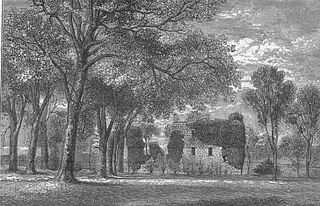
Hessilhead is in Beith, North Ayrshire, Scotland. Hessilhead used to be called Hazlehead or Hasslehead. The lands were part of the Lordship of Giffen, and the Barony of Hessilhead, within the Baillerie of Cunninghame and the Parish of Beith. The castle was situated at grid reference NS380532.

The River Irvine is a river that flows through southwest Scotland. Its watershed is on the Lanarkshire border of Ayrshire at an altitude of 810 feet (250 m) above sea-level, near Loudoun Hill, Drumclog, and 7 miles SW by W of Strathaven. It flows 29+1⁄2 mi (47.5 km) westward, dividing the old district of Cunninghame from that of Kyle, until it reaches the sea via Irvine Harbour in the form of the Firth of Clyde, and flows into Irvine Bay by the town of Irvine. It has many tributaries, some of which form parish, district and other boundaries.

Baron of Aiket (extinct) was a title of nobility in the Baronage of Scotland for the holder of the Barony of Aiket with its castle, lay within the old feudal bailiary of Cunninghame. The barony lands equate to the extant Parish of Dunlop, East Ayrshire, Scotland.

The Barony of Bonshaw, previously known as Bollingshaw, was in the old feudal Baillerie of Cunninghame, near Stewarton in what is now North Ayrshire, Scotland.

Busbie Castle was situated in what is now known as Knockentiber, a village in East Ayrshire, Parish of Kilmaurs, Scotland. Knockentiber is 2 miles (3.2 km) WNW of Kilmarnock and 1/2 mile NE of Crosshouse. The castle overlooked the Carmel Glen and its Burn, which runs into the River Irvine, a mile or so to the south, after passing through the old Busbie Mill.
Lieutenant-Colonel Charles Somerville MacAlester of Loup and Kennox (1797–1891) was a son of Charles MacAlester and Janet Somerville. He was born in Scotland in 1797 and was a chief of Clan MacAlister.
Lieutenant Colonel Charles Godfrey McAlester 12th of Loup, Chief of Clan MacAlister, was the son of Angus MacAlester and Jane MacDonald.
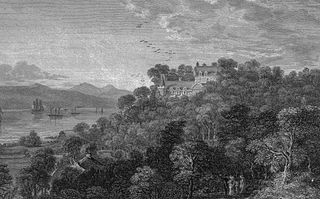
Skelmorlie Castle stands on the eastern shore of the Firth of Clyde, Scotland, at the north-western corner of the county of Ayrshire. The structure dates from 1502, and was formerly the seat and stronghold of the Montgomery Clan. The modern village of Skelmorlie lies to the north of the castle.
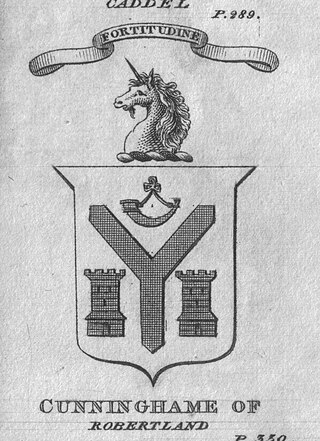
The Castle and Barony of Robertland is located near Stewarton, off the B769 road, in the old district of Cunninghame, Parish of Stewarton, and now part of East Ayrshire, Scotland.
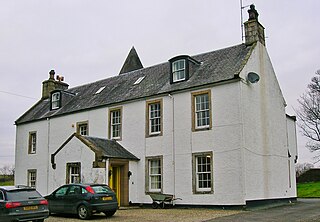
Monkredding formed a small estate in the Parish of Kilwinning, North Ayrshire lying between Kilwinning and Auchentiber on the B778. The property was originally held by the Tironensian monks of Kilwinning Abbey and was the 'Monk's Garden', the rest home for the brothers. Monkcastle near Dalgarven was the abbot's country retreat. Monkredding remains in good condition and is in use as a private house in 2010.

The Lands of Lainshaw lie in Strathannick and were part of the Lordship of Stewarton, in East Ayrshire, Scotland. Lainshaw House is a category B listed mansion, lying in a prominent position above the Annick Water and its holm in the Parish of Stewarton, Scotland. Part of the much older Lainshaw Castle is contained within the several later building phases of the present day Lainshaw House. The names 'Langshaw' or 'Langschaw' were used in historic times. Law Mount near the High and Laigh Castleton farms has been suggested as the site of the original castle, granted in the 12th century to Godfrey de Ross by Hugo de Morville.

The Lands of Pitcon, previously Potconnel now form a small estate of around 100 acres in the Parish of Dalry, North Ayrshire in the old Barony of Dalry. The present category B listed Georgian mansion house dating from 1787, replaces an older castellated dwelling. Pitcon lies on the outskirts of Drakemyres, now a suburb of Dalry, close to the confluence of the Rye Water, River Garnock, and the Mains Burn, standing on a low knoll. Such a marshy area would have provided a degree of protection to the old castle.
The lands of Broomlands or Broumlands formed a small country estate about a mile to the east of Irvine, North Ayrshire, Scotland situated on the east bank of the Annick Water in the Parishes of Dreghorn and Irvine.

The Murder of Hugh Montgomerie, 4th Earl of Eglinton at the Annick Ford in Stewarton, East Ayrshire, Scotland, took place in 1586 as a consequence of a long running feud between the Montgomeries, Earls of Eglinton and the Cunninghames, Earls of Glencairn, families who were competing for power and influence locally and nationally. The significant repercussions of this act were felt throughout the county of Ayrshire and beyond. The spelling 'Montgomerie' is used throughout for both the family and Montgomery for the clan and clan and district names 'Cunninghame' in the same fashion.